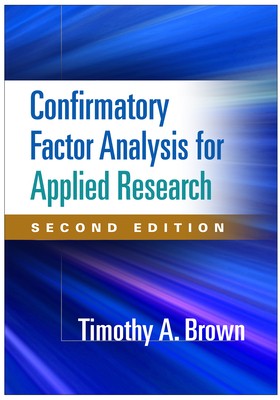
- We will send in 10–14 business days.
- Author: Timothy A Brown
- Publisher: Guilford Publications
- ISBN-10: 146251779X
- ISBN-13: 9781462517794
- Format: 18.3 x 25.7 x 3.1 cm, kieti viršeliai
- Language: English
- SAVE -10% with code: EXTRA
Confirmatory Factor Analysis for Applied Research (e-book) (used book) | bookbook.eu
Reviews
Description
With its emphasis on practical and conceptual aspects, rather than mathematics or formulas, this accessible book has established itself as the go-to resource on confirmatory factor analysis (CFA). Detailed, worked-through examples drawn from psychology, management, and sociology studies illustrate the procedures, pitfalls, and extensions of CFA methodology. The text shows how to formulate, program, and interpret CFA models using popular latent variable software packages (LISREL, Mplus, EQS, SAS/CALIS); understand the similarities and differences between CFA and exploratory factor analysis (EFA); and report results from a CFA study. It is filled with useful advice and tables that outline the procedures. The companion website (www.guilford.com/brown3-materials) offers data and program syntax files for most of the research examples, as well as links to CFA-related resources.
New to This Edition*Updated throughout to incorporate important developments in latent variable modeling.
*Chapter on Bayesian CFA and multilevel measurement models.
*Addresses new topics (with examples): exploratory structural equation modeling, bifactor analysis, measurement invariance evaluation with categorical indicators, and a new method for scaling latent variables.
*Utilizes the latest versions of major latent variable software packages.
EXTRA 10 % discount with code: EXTRA
The promotion ends in 21d.09:31:47
The discount code is valid when purchasing from 10 €. Discounts do not stack.
- Author: Timothy A Brown
- Publisher: Guilford Publications
- ISBN-10: 146251779X
- ISBN-13: 9781462517794
- Format: 18.3 x 25.7 x 3.1 cm, kieti viršeliai
- Language: English English
With its emphasis on practical and conceptual aspects, rather than mathematics or formulas, this accessible book has established itself as the go-to resource on confirmatory factor analysis (CFA). Detailed, worked-through examples drawn from psychology, management, and sociology studies illustrate the procedures, pitfalls, and extensions of CFA methodology. The text shows how to formulate, program, and interpret CFA models using popular latent variable software packages (LISREL, Mplus, EQS, SAS/CALIS); understand the similarities and differences between CFA and exploratory factor analysis (EFA); and report results from a CFA study. It is filled with useful advice and tables that outline the procedures. The companion website (www.guilford.com/brown3-materials) offers data and program syntax files for most of the research examples, as well as links to CFA-related resources.
New to This Edition*Updated throughout to incorporate important developments in latent variable modeling.
*Chapter on Bayesian CFA and multilevel measurement models.
*Addresses new topics (with examples): exploratory structural equation modeling, bifactor analysis, measurement invariance evaluation with categorical indicators, and a new method for scaling latent variables.
*Utilizes the latest versions of major latent variable software packages.


Reviews